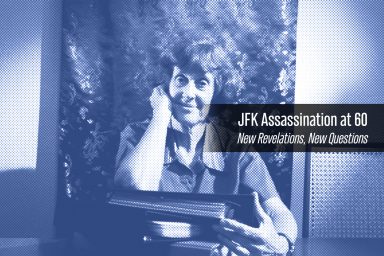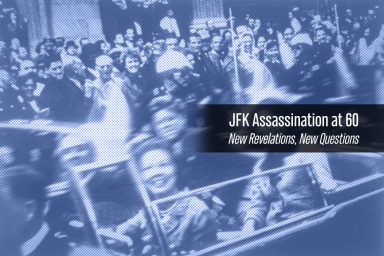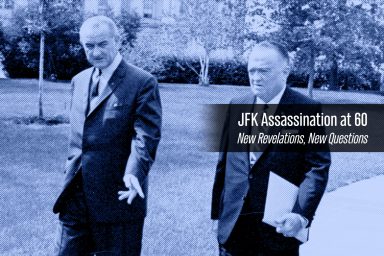The myth that Lee Harvey Oswald was a Soviet agent is a convenient fabrication that just won’t die — and one that implicates the CIA.
This story is part of our series revisiting the JFK assassination. To understand why we’re doing this, read our introduction.
In mid-December, the Biden administration released nearly 1,500 documents related to the John F. Kennedy assassination. Out of all the intelligence agencies memoranda, dossiers, and interview transcripts, the media has seized upon one: a CIA memo about Lee Harvey Oswald’s supposed in-person meeting with Valery Kostikov, a notorious KGB official, in Mexico City in September 1963.
There’s nothing new about the memo in question. The same is true for most of the JFK records released in December. But as a round of fresh press coverage indicated, the encounter suggests Oswald was working for the Soviets, and that America’s Cold War nemesis was responsible for Kennedy’s killing — not the mob, anti-Castro Cubans, the CIA, or the military-industrial complex.
The theory that Oswald was a KGB asset has persisted for decades, despite a lack of evidence. Even the CIA concluded that any contact Oswald had with KGB-affiliated Russians was a “grim coincidence.” (A man claiming to be Oswald did contact the Soviets in Mexico City — but that man was an impostor.)
This most recent recycling of the “Oswald and the Russians” story — the JFK assassination’s very own Russiagate — follows a predictable pattern that appears every time there’s a release of JFK records. It happened in 2017 and during the 1990s.
So, what gives? Why does the media gravitate toward the Oswald/KGB “revelation” every few years rather than any of the other more plausible theories?
This reliable rhythm suggests reporters are being encouraged to push this story, which also steers the conversation firmly away from potential domestic conspirators. The likeliest suspect behind any media manipulation — the entity that stands to benefit the most from misdirection — also happens to be the main suspect many researchers believe was involved in the assassination: the CIA.
Blame It on the Dead
With Oswald long dead and the USSR collapsed, purported “proof” that Oswald was working with the Soviets wraps up the case in the easiest way. The killer and the plotters are all long gone. Nothing else needs to be done.
This theory also exonerates the Warren Commission for its inadequate investigation, as well as the national security agencies that have refused to disclose all they know about JFK’s assassination. It also ignores the many signs that suggest Oswald may indeed have been an intelligence asset — but the CIA’s, an agency whose very existence was threatened by John F. Kennedy.
Oswald was almost certainly an agent for someone. As former Sen. Richard Schweiker (R-PA) once said, “Everywhere you look with him, there are fingerprints of intelligence.”
Circumstantial evidence suggests Oswald was recruited into the US intelligence community while in the Marines. Through this lens, everything Oswald did, including learning Russian while a teenaged Marine and “defecting” to the Soviet Union at 19 in 1959, was carefully choreographed.
Regardless of his actual allegiance, as a former defector, Oswald was well known to domestic intelligence and closely monitored.
Yet the FBI, CIA, and other federal agencies suppressed this information from the Warren Commission, important context most of the recent news coverage omits.
But much of the misdirection focuses on Oswald’s supposed activities in Mexico City.
Montezuma’s Revenge
The truth about what really happened in the Mexican capital remains elusive, but even conspiracy skeptics believe Oswald’s presumed actions there may hold the solution to the entire puzzle.
“It is startling to discover how many credible government officials — beginning with Ambassador Mann and CIA station chief Scott — have suggested that evidence was missed in Mexico that could rewrite the history of the assassination,” observed A Cruel and Shocking Act: The Secret History of the Kennedy Assassination author Philip Shenon, who is considered a Warren Commission shill. “The list includes the late former FBI Director Clarence Kelley and former FBI Assistant Director William Sullivan, as well as David Belin, a former staff lawyer on the Warren Commission.”

Lee Harvey Oswald and Marina Oswald leaving Russia for America, in May 1962. Photo credit: (FBI B3-30) Commission Exhibit No. 2629
According to the Warren Commission, on September 26, 1963, Oswald boarded a Greyhound bus in Houston bound for Mexico City.
The purpose of his visit, we are told, was to obtain transit visas from the Cuban Embassy in order to return to the USSR, where Oswald lived from October 1959 to June 1962. There he was, hoping to go back, even though he had gladly fled the totalitarian state and publicly expressed how happy he was to be living in the US again.
Oswald’s plans were foiled when the Cubans told him that he would need a Soviet visa. This, the Soviet Embassy said, would take months to obtain. Infuriated, Oswald left for Texas on October 2 to plot the crime of the century.
There are some indications that Oswald did travel to Mexico City, including the testimony of fellow passengers on the same bus headed south of the border. Yet his exact actions there have been shrouded in secrecy, thanks mostly to the CIA’s obstruction and obfuscation.
At the center of the controversy is a single phone call.
The Phone Call
Until the formation of the House Select Committee on Assassinations (HSCA) in the late 1970s, the Mexico City enigma was a little-known footnote, but testimony from new witnesses, reinterviews of old ones, and the declassification of relevant records indicated it was much more.
An HSCA summary of the Oswald trip to Mexico known as the Lopez Report was so explosive that it would not become public until 1993, albeit heavily redacted. Along with the Lopez Report, many other records released in the 1990s by the Assassination Records Review Board (ARRB) provided powerful evidence that the CIA was intentionally deceitful about almost everything that occurred there, as well as its interest in Oswald prior to the assassination.
Many of those ARRB records, including the one that has captured the media’s focus — a 1963 memo written by the then-acting chief of the CIA’s Soviet counterintelligence division Tennent H. Bagley — concern the phone call purportedly made by Oswald to the Soviet Embassy on October 1, 1963.
Speaking in broken Russian — which Oswald spoke nearly fluently — a caller identifying himself as Oswald to the Soviet official on the other end of the line sought more information about his visa request.
This person also mentioned that, on his first visit to the Soviet Embassy a few days earlier, he met with Valery Kostikov, whom the CIA fingered as an “identified KGB officer” affiliated with the security service’s “13th Department,” responsible for assassinations and sabotage.
Because the CIA was tapping the embassy’s phone lines, the call was recorded. Although the CIA claimed the tape was erased, a couple of attorneys on the Warren Commission’s staff supposedly heard the call in April 1964. (It has never been heard publicly.)
These attorneys, William Coleman Jr. and David Slawson, said the voice was Oswald’s. Not everyone agreed. In a phone conversation with Lyndon B. Johnson the morning after the murder, FBI Director J. Edgar Hoover said Oswald was being impersonated.
“That picture and the tape do not correspond to this man’s voice, nor to his appearance,” Hoover told the new president, according to a transcript declassified in 1993.
“In other words, it appears that there is a second person who was at the Soviet embassy down there.”

These photographs, which CIA personnel in Mexico City mistakenly linked to Lee Harvey Oswald, depict a man who was never conclusively identified. One mystery of the JFK assassination is why Oswald was not photographed when he visited the Soviet Embassy in Mexico City. Photo credit: JFK Archives
The true identity of this man is still unknown, but he is thought to have been an American serviceman, light-haired, stout, and in his mid-30s. Oswald was 24, dark-haired, and slender.
CIA surveillance cameras photographed everyone entering or leaving the Soviet and Cuban embassies in Mexico. Why have they never produced one single photo of Oswald even though he reportedly made several visits between the two buildings? The only photos to appear are of this “Mexico City Mystery Man,” as he has been dubbed. Was he the mystery man pretending to be Oswald on the phone?
While this does not necessarily mean that Oswald never visited the embassies (some eyewitness testimony suggests that he did), it begs the question why the Mexico City material was suppressed until its partial release in the early 1990s.
“Spy” Gone Free
After a cable describing the phone call was sent from the CIA’s Mexico City station to headquarters in Langley, VA, on October 9, 1963, it was then forwarded to the FBI, the State Department, and the Navy. Missing, however, from the CIA’s cable to its counterparts was the fact that it was Kostikov the supposedly phony Oswald was speaking with.
The CIA knew Kostikov as a spy, thought to be involved in all the craft’s darkest arts. A notorious foreign intelligence agent meeting with a former defector to Russia should have set off alarm bells.
Yet the CIA chose to keep this information to itself.
Oswald was thus allowed to stay off the FBI’s security index, a list of individuals deemed national security risks. As former FBI Director Clarence Kelley wrote in his memoir, had Oswald been placed on the Security Index, he would have at least been put under heavy surveillance — and not allowed to be in a building directly overlooking the president’s motorcade.
Depending on one’s opinion about Oswald’s guilt, the CIA’s withholding of such vital information was either grossly negligent or suggests the agency was running a complex intelligence operation that involved Oswald in the weeks leading up to November 22, 1963.
Either way, the fingerprints that appear on Oswald’s actions in Mexico are the CIA’s — not the KGB’s.
Careful analysis of the CIA cable traffic and interagency memos from that time has led some researchers to believe that the agency was involved in a complicated game of deception in Mexico City, using falsified information and parlor tricks to try and smoke out possible KGB moles within its ranks. Given the ease he enjoyed reentering the States, Oswald was probably not a genuine defector, but with the apparent bona fides of a Castro and Khrushchev-loving commie he seems to have been essential to the CIA’s goals.
Cui Bono? Not the Kremlin
Any effort to blame the Soviets for JFK’s murder fails to address the issue of motive. If the Soviets were somehow complicit in his assassination, why would they so clumsily impersonate Oswald? What would they gain by parodying the man tasked with carrying out the murder of the century, in a way that they knew would be observed by the CIA?
Further, if Oswald killed Kennedy on Moscow’s orders, the Soviets would have been taking an existential risk that could have resulted in total annihilation.
American military leadership was eager for any excuse to launch a nuclear attack against the Soviet Union. During the 1962 Cuban Missile Crisis, Soviet Premier Nikita Khrushchev learned through his US ambassador that JFK feared his own military might overthrow him if he did not authorize an all-out attack on the sites where Soviet missiles were stored.
Even the mere thought among the American public that the Kremlin had killed the president on US soil could have triggered World War III. Newly sworn in President Johnson used these fears to force Chief Justice Earl Warren onto the investigative commission of JFK’s death.
(Ironically, this fear has been used to explain the CIA’s actions in another, more rosy depiction of the agency’s motives: The CIA deliberately covered up signs that Oswald was a communist infiltrator, to save us from nuclear war.)

US President John F. Kennedy and Soviet Chairman Nikita Khrushchev meet at the US Embassy in Vienna, Austria, June 3, 1961. Photo credit: JFK Library
Would the USSR really assassinate Kennedy? As an act of self-harm? If they were the true culprits, how could they expect their heinous act to be covered up to avoid a nuclear war they would invariably lose?
Unlike the version of reality US intelligence fed to both Eisenhower and Kennedy, the only “missile gap” was the US stockpile’s huge advantage over their Soviet adversaries.
In the Oswald/KGB theory, this was a risk the Soviets took.
Moreover, the notion that Khrushchev wanted to take JFK out is not supported by the known facts.
After the apocalyptic near-miss of the Cuban Missile Crisis, Kennedy and Khrushchev sought rapprochement, both personally and between their respective nations; and it was working. From signing a nuclear test ban treaty to secretly writing each other over a hundred letters, the two men were beginning to find common ground.
There has been rampant speculation about Fidel Castro’s potential involvement in a plot against Kennedy, given the numerous failed attempts on the Cuban revolutionary leader’s life orchestrated by the CIA with the president’s tacit approval.
However, like Khrushchev, available evidence indicates Castro was also seeking a closer relationship with Kennedy following the Missile Crisis — and that the president’s assassination shook him to the core.
Jean Daniel, a French journalist secretly tasked by JFK to gauge Castro’s interest in détente, was interviewing the Cuban leader the afternoon of November 22, when a phone call interrupted to inform them Kennedy had been shot.
“Es una mala noticia,” (“This is bad news”) a dejected Castro muttered as he hung up the phone, repeating it two more times, according to Daniel.
A half-hour later, a second call was patched through. The president was dead. Castro fixed his gaze on Daniel. “Everything is changed,” he said.
The Original Big Lie
Two people who did not suspect the Soviet Union were Jackie and Robert Kennedy. The president’s widow and brother privately believed that the plot against JFK originated in right-wing factions of the US national security state.
In 1997, it was learned that William Walton, a journalist and family friend of the Kennedys, was sent by the two on a secret mission to Moscow in early December 1963. He met with Georgi Bolshakov, a Soviet military intelligence officer who played a crucial role in de-escalating the Missile Crisis a year earlier.
Walton told Bolshakov that the Kennedys believed JFK was “felled by his domestic opponents” within the far-right, and that if Oswald was involved, he did not act alone. Bolshakov, for his part, denied the Soviet Union’s involvement.
Why Can’t the Media Get the Story of the JFK Documents Right?
President Kennedy had privately worried about a possible coup d’état, going so far as to encourage director John Frankenheimer to shoot scenes at the White House for the film adaptation of Seven Days in May, a book about a military coup that unseats a democratically elected US president for his efforts to seek comity with the Soviet Union.
Frankenheimer later revealed that Kennedy wanted to warn the nation about the dangers of unchecked military power and extremist elements within its leadership.
Despite Kennedy’s fears of a coup, especially during the harrowing days of the Cuban Missile Crisis, the media — both traditional and alternative — stubbornly refuse to acknowledge this part of the historical record, focusing instead on the flimsy, illogical theory that the Soviets were involved in an assassination plot.
With Russia constantly in the news the last several years, it is worth considering whether the “Oswald was a KGB agent” hokum is part of a broader propaganda campaign.
While former President Donald Trump does have extensive ties to Russian oligarchs and gangsters, the media has nonetheless been guilty of fomenting a new Cold War, pinning disproportionate blame on Putin’s Russia for a variety of domestic problems.
It should be noted that there is precedent for the Fourth Estate being co-opted by the very national security agencies it is supposed to hold to account. Printing their version of events, even if demonstrably false or misleading, guarantees future access for the media.
A common tactic of the CIA (and its national security brethren) is what’s known as a “limited hangout,” where the agency ostensibly offers a mea culpa for its misdeeds, while actually feeding disinformation for its own benefit. The truly scandalous and embarrassing information remains hidden from view or at least minimized.
Pushing the narrative that Oswald was tied up with the KGB steers blame away from Americans to a foreign other and conceals something much more plausible — and sinister.



